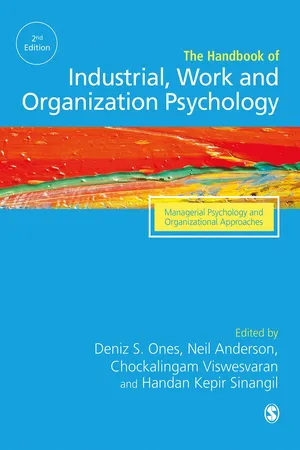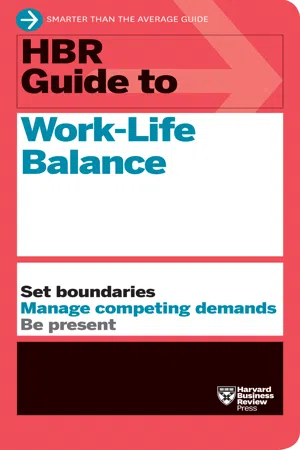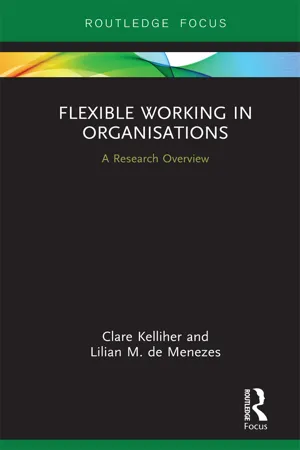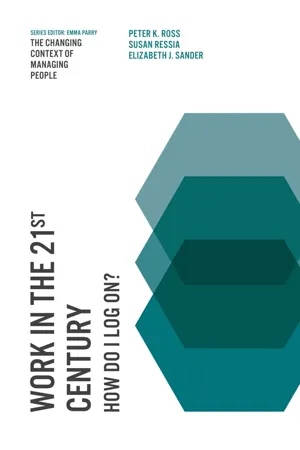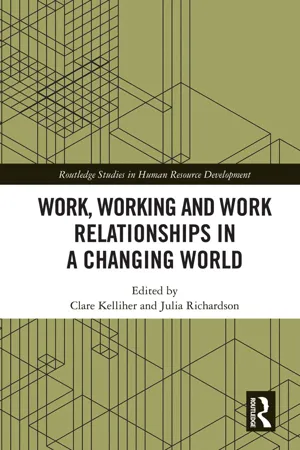Business
Flexible Work Arrangements
Flexible work arrangements refer to non-traditional work schedules or locations that allow employees to have more control over when and where they work. This can include options such as remote work, flexible hours, compressed workweeks, or job sharing. These arrangements can help improve work-life balance, increase employee satisfaction, and attract and retain top talent.
Written by Perlego with AI-assistance
Related key terms
10 Key excerpts on "Flexible Work Arrangements"
- eBook - ePub
The SAGE Handbook of Industrial, Work & Organizational Psychology
V3: Managerial Psychology and Organizational Approaches
- Deniz S Ones, Neil Anderson, Chockalingam Viswesvaran, Handan Kepir Sinangil(Authors)
- 2015(Publication Date)
- SAGE Publications Ltd(Publisher)
25 Alternative Work Arrangements Catherine E. Connelly Megan E. MurphyIntroduction
Workplaces are changing. No longer is it assumed that every worker will be employed with a single employer for his or her entire career, and no longer do all employees work 40-hour weeks at the office. Alternative work arrangements, such as temporary work, contracting, part-time employment, and telecommuting are not new; they have always existed in different formats. However, in contemporary workplaces, it is now understood that many workers and employers will have a significant degree of flexibility in terms of when, where, and how work is completed. We need to consider carefully how the context of employment affects worker attitudes and behaviors.Moreover, workers with alternative employment arrangements cannot be treated as a homogenous group. For example, the impact of the length (i.e. short duration) of an employment contract is potentially qualitatively different than the impact of its variability (i.e. job insecurity). That is, while some employees with fixed-term contracts will find this arrangement stressful, this is not necessarily the case for all employees in this category. In this chapter, we therefore discuss three of the most common alternative work arrangements: telecommuting, part-time employment, and contingent work (described in Table 25.1 ). In particular, we discuss how individual workers’ attitudes and behaviors are shaped by these arrangements, with a particular focus on organizational commitment, job satisfaction, work stress, and work–life balance. In our concluding remarks, we discuss new and growing types of alternative work arrangements that should receive more attention, and we identify international differences in alternative work arrangement research that warrant additional study.Telecommuters
Many employees express a preference to have more discretion in terms of when and where they complete their work tasks (Shockley & Allen, 2007). One example of location-based flexibility is the practice of ‘distributed work', or arrangements that allow employees to be placed away from a central organizational location (Bélanger & Collins, 1998). One form of distributed work, telecommuting, also known as remote work or telework, has become very common. Telecommuters are ‘individuals who are employed by an organization but who work at home or at a telecenter for some portion of their working time during regular business hours’ (Duxbury & Higgins, 2002, p. 157). - eBook - ePub
Smart Flexibility
Moving Smart and Flexible Working from Theory to Practice
- Andy Lake(Author)
- 2016(Publication Date)
- Routledge(Publisher)
It’s very much about high trust and managing by results. Expectations are set for time together as a team, and individuals are clear on expected outputs, but we encourage line-manager discretion when employees look to vary their working pattern. We prefer informal arrangements rather than over-engineered policies or a bureaucratic approach. Working from home can be a great way to avoid lengthy commutes and maximises your time and personal effectiveness so you can keep those commitments outside work. And our arrangements are not just for parents, – we know everyone has commitments in their life outside work, so we also encourage people to undertake volunteering or participate in sporting and other social activities.Helping employees achieve a good work-life balance remains a key aim for Britvic. As people have to travel to work within the congested South East of England, physical meetings are typically scheduled between 10 a.m. and 4 p.m. to allow leeway for travel and other responsibilities. Meanwhile, the focus remains on getting the job done, wherever and whenever is best for the individual and compatible with team arrangements. Sue sums up their approach:Flexible working is absolutely critical for the modern business. It’s the way to attract and retain the best people. We’ve tried hard to get the balance right between the needs of the business and the needs of individual employees, and to create a physical centre for collaboration which is the heart of the company. We’re delighted that our approach to flexibility has meant that we’re able to retain so many of our employees during this relocation. We absolutely believe that creating such an inspiring and collaborative workspace will further enhance team-working, strengthen relationships and improve overall effectiveness.In the Future, Flexible Work = Work
I remember hearing a paper at a European conference on ‘ework’. The speaker was saying that previously in European circles ework had been referred to as ‘telework’. So we had progress, he said. We’d lost the first three letters from the word, now we just had to lose the ‘e’. Telework, or ework, would have come of age when we no longer talk about it. When it is just ‘work’. - eBook - ePub
- Harvard Business Review(Author)
- 2019(Publication Date)
- Harvard Business Review Press(Publisher)
SECTION THREE
Explore Flexible Work Arrangements
Passage contains an image
CHAPTER 10
Winning Support for Flexible Work
by Amy Gallo
Many professionals seek Flexible Work Arrangements to accommodate lives that don’t mesh with a 9-to-5 day. Yet few companies have official policies or programs for alternative schedules—and just as few managers are willing or equipped to provide them for members of their teams. This doesn’t mean you should give up on the idea of flextime if it would help you cut down a lengthy commute or avoid burnout. It just means that the onus is on you to propose a plan that works for you, your boss, and your company.What the Experts Say
Before you pursue a flexible schedule, recognize that you’re likely to be bucking long-held conventions. “Traditionally, managers were reluctant to have people work remotely because of lack of trust: Are you really working, or are you eating bonbons with your friend?” explains Stewart D. Friedman, founding director of the Wharton School’s Work/Life Integration Project. Even those bosses who trust their employees worry about appearing to favor certain people or allowing productivity to decline.Still, some managers and organizations are reaping the benefits of nontraditional schedules. Research from Lotte Bailyn, MIT management professor and coauthor of Beyond Work-Family Balance , shows that when employees have the flexibility they need, they meet goals more easily, they’re absent or tardy less often, and their morale goes up. By focusing on these upsides and thoughtfully framing your request around them, you greatly increase your chances of getting approval for an alternative work arrangement.Define What You Want
The first step is to figure out what you’re trying to accomplish. Is your goal to spend more time with family? Less time at the office? Or do you want to remove distractions so you can focus on bigger, longer-term projects? Once you’re clear on your goal, decide how you can achieve it while still doing your job effectively. Options include a compressed workweek, a job share, working from home, and taking a sabbatical. Of course, not every job is suited for a flexible arrangement. Before you make a proposal, think carefully about the impact your wished-for schedule will have on your boss, your team, and your performance. - eBook - ePub
Flexible Work
Designing our Healthier Future Lives
- Sarah H. Norgate, Cary L. Cooper(Authors)
- 2020(Publication Date)
- Routledge(Publisher)
Employees may seek part-time or temporary employment to manage their non-work commitments themselves, while employers may accommodate the flexible work needs of core employees in order to retain them. The literature is unclear as to whether and how employers use flexible workplace practices to manage employee flexible work needs and the extent to which employees avail themselves of numerical flexible positions to self-manage their flexible work needs. The various types of FWAs are explained next so they can be matched with the flexible work needs of employees in various age groups.Types of Flexible Work Arrangements requested by employees
In contrast to employer flexible practices, employees primarily initiate FWAs (Kelliher & Anderson, 2010; Russell et al., 2009), which may require specific structures and systems to administer. FWAs are important to social sustainability of employees and are key components of high-performance work systems (Wang et al., 2011; Posthuma et al., 2013). They take various forms and include flexible start and finish times, compressed work time, flexible leave entitlements, reduced work hours, job sharing and telecommuting or working from home (Fairwork Ombudsman, 2016).Employees who work flexible hours are able to start or leave early/late or compress their work hours, i.e. work longer hours on specific days and take longer breaks on others. However, they must work the standard daily, weekly or monthly hours and be available for work during core periods (Fairwork Ombudsman, 2016). In general, these FWAs do not involve profound changes to work organisation and entail little or no cost to employers (Thevenon et al., 2016). Employers are therefore, often willing to accommodate flexible work hours and it is the most common form of FWA provision (OECD, 2019a). Employees can access similar flexibility by selecting shifts or roster times that suit their personal circumstances, trading off payment for overtime work on some days with reduced hours on other days, i.e. time off in lieu, or compressing their workweek into fewer days (Riedmann et al., 2006). Depleted energies from long hours of compressed work could impact performance negatively.Employers may also allow flexible use, accrual or extension of leave entitlements with or without pay (Australian Fair Work Act 2009). For flexible leave to be effective, the timing must be discussed in advance to enable work of employees on leave to be covered (Kotey & Sharma, 2016). Flexible leave allows employees to allocate time to critical family and personal needs. - eBook - ePub
Flexible Working in Organisations
A Research Overview
- Clare Kelliher, Lilian M. de Menezes(Authors)
- 2019(Publication Date)
- Routledge(Publisher)
approach were included in the measure of family-friendliness, meaning that flexible working arrangements were bundled with childcare and other practices that were targeted at parents. Furthermore, some authors differentiated between regular and irregular flexible working arrangements, while others discriminated between formal and informal arrangements, the amount of actual choice available to the employee or the degree to which the arrangement could be customised. Similar variations in measures and definitions were also observed with respect to types of flexible working arrangements, as shown in the second part of the table, and are consistent with observations from a recent review of the literature that was restricted to examining telecommuting (Allen, Golden and Shockley, 2015). In summary, taking into account the variance in what has been measured in the literature, there is a need to be careful in interpreting and making generalisations from findings.It is noteworthy that the research in relation to flexible working has emerged in a number of identifiable phases. Figure 3.1 illustrates the evolution of this research. Early interest in the 1970s was concerned with attempting to assess the impact of flexitime on worker performance. From the late 1980s onwards studies began to focus on remote working when developments in information technology enabled greater working away from the workplace. The late 1990s and the 2000s saw interest emerging in the use of ‘family-friendly practices’ addressing the provision of flexible working arrangements as part of programmes designed to assist employees achieve a better work–life balance. More recently we have seen a concern to evaluate the extant evidence, with a number of literature reviews and meta-analyses being published, along with greater examination of factors mediating the relationship between flexible working arrangements and performance-related outcomes.In the next sections an overview of the accumulated body of evidence on the likely outcomes from the offering and uptake of flexible working arrangements will be presented. In reporting the findings, we consider a causal chain from management practices to performance, as represented in several recent studies of the management practice performance nexus (e.g. Wood, Van Veldhoven, Croon and de Menezes, 2012). As shown in Figure 3.2 - eBook - ePub
- Peter K. Ross, Susan Ressia, Elizabeth J. Sander, Emma Parry(Authors)
- 2017(Publication Date)
- Emerald Publishing Limited(Publisher)
2.3. Telework and Flexible Work Practices
The above technologies support telework and flexible work practices. Telework has been defined as “…a flexible work arrangement whereby people work in locations, remote from their central offices with no personal contact with co-workers, but the ability to communicate with co-workers using ICT” (Di Martino & Wirth, 1990, as in Bosua, Gloet, Kurnia, Mendoza, & Yong, 2013, p. 11.1). Telework therefore allows employees to “perform their work either at home or from a satellite office space where an employee has access to technologies that enable them to work from such locations” (Ross & Ressia, 2015; Shin, Sheng, & Higa, 2000, p. 85).Little is known, however, about the impact of these new ICT technologies on the well-being of employees and families (Coenen & Kok, 2014; Demerouti et al., 2014; Fonner & Stache, 2012; Hilbrecht & Lero, 2013; Troup & Rose, 2012). Telework is one form of flexible work arrangement located within a realm of work/family policy (Troup & Rose, 2012). The benefits of these policies are that they can assist workers in reaching a suitable balance between employment related and nonemployment related demands (Coenen & Kok, 2014; Fonner & Stache, 2012). These policies began to emerge during the 1990s (Burgess & Strachan, 2005) where the joint management of work and family commitments were frequently seen as a “conflict” or “collision” giving rise to the problem of achieving balance between the competing demands of paid and unpaid work (Burgess & Strachan, 2005; Greenhaus & Beutell, 1985, p. 77; Pocock, 2003, 2005). Work interfering with family life has significant consequences on an individual’s ability to maintain marital and family relationships, whilst conversely, family interfering with work can cause significant issues for employees’ career progression, contributions to their job, and increases in absenteeism rates that can lead to voluntary turnover (Parasuraman & Greenhaus, 1997). - eBook - ePub
Love Your Job
The New Rules for Career Happiness
- Kerry E. Hannon(Author)
- 2015(Publication Date)
- Wiley(Publisher)
And I smile as I type this sentence while those horses thunder by at a gallop in their grassy field. For me, that’s the sweet sight (and sound) of having flexibility in my work life.In this chapter, you will learn about various Flexible Work Arrangements that you might be able to take advantage of and how to ask your boss if you can try it out. I will show you how and why you and your employer can benefit. I will also review the pros and cons of the various kinds of Flexible Work Arrangements to give you a better understanding of how they work and whether or not such as arrangement might work for you and your employer.Work Flexibility and Happiness
Before I dive into the pros and cons of building flexibility into your job—be it through telecommuting or other flexible work schedules—and why and how you and your employer can benefit, let me take a minute to give you the view from the top about the current state of workplace flexibility and telecommuting.The appeal of working from home, or remotely, whether full time or part time, is easy to understand. As I have said, it gives us a sense of autonomy and control of our time. When it comes to what makes people love their jobs, this is a biggie. Telecommuting employees are happier and more loyal, and they have fewer unscheduled absences, according to a survey by outplacement firm Challenger, Gray & Christmas. My research and interviews with hundreds of workers have clearly shown that more flexibility in scheduling day-to-day activities leads to greater happiness on the job. That’s especially true as you get older.According to Cali Williams Yost, an expert on managing work and life and author of Tweak It: Make What Matters to You Happen Every Day (Tweakittogether.com and http://worklifefit.com/blog/ - eBook - ePub
- Katherine Lockett(Author)
- 0(Publication Date)
- For Dummies(Publisher)
Everyone wants flexible working options available if and when needed. Employees also want their bosses to have guidelines to help consider employee requests fairly and promptly. I’ve done some of the hard work and sought out options that are tried and tested by many employers and have been shown to work. Some options that may suit your workplace includeCompressed work week:Working a full-time week in four days.Flexi-time:Starting and finishing at variable times.Job sharing:Two people split one job.Part-time working:Working less than standard full-time hours.Telecommuting:Working from home on a regular or as-needs basis.For more information on these options, refer to Chapter 8. Personal work/life balanceTerm-time working:Working only during school terms.Development plans let managers and companies review work/life balance policies on a regular basis. Planning ahead for the busiest working times or recruitment drives or accommodating the changing needs of staff (for example, people moving from full-time to part-time work) can be done usingAn open-door approach to problems, as well as groups for managers to establish good rapport with their staff to ensure that business and personal needs are metIndividual development plans and regular appraisalsMentoring by experienced colleagues or by external trainersIn addition to standard amounts of annual leave, sick leave and maternity leave, employers are increasingly adopting more flexible leave options to attract and retain their valued staff and listing them in their work/life balance policies. These new options can includeAdditional purchased holiday leave:This leave is commonly known as 48/52 where an employee gains four weeks of extra leave and spreads the salary impact of this leave without pay over each salary period for the year.Career breaks or sabbaticals: - Clare Kelliher, Julia Richardson(Authors)
- 2018(Publication Date)
- Routledge(Publisher)
For many knowledge workers, teleworking is the new normal. Telework refers to the practice of working away from the office for some part of the work week, while keeping in contact using information technology (Bailey & Kurland, 2002; Allen, Golden & Shockley, 2015). This practice is growing in popularity on both sides of the Atlantic, with research from the Trades Union Congress demonstrating that the number of employees who report “usually” working from home increased by 19% between 2005 and 2016 in the United Kingdom, and US Census Bureau data showing that the number of American employees working on a regular basis from home grew by 115% between 2005 and 2015 (Calnan, 2016; Global Workplace Analytics, 2017). This trend is also represented in other parts of the world; for instance, Argentina has seen teleworkers increase from 320,000 in 2004 to approximately 2 million in 2014 (Munhoz, 2016), while 19% of non-agricultural workers in India’s formal economy work at least one day a week from home (Eurofound and the International Labour Office, 2017). In Japan, where “face time” in the office has typically been an important element of workplace culture, the Ministry of Economy, Trade and Industry is promoting trial “telework days” in an effort to reduce the harmful effects of the long-hours culture as well as to prepare for the 2020 Olympics when commuting to work is likely to be significantly disrupted (Reuters, 2017). The expansion of telework can be attributed to the benefits that it brings for both employees and employers; research consistently finds that working from home is associated with increased levels of job satisfaction (Fonner & Roloff, 2010; Gajendran & Harrison, 2007), and organizations report significant cost savings due to reduced overheads. For example, Sun Microsystems found annual savings of $64 million in real estate costs and $2.5 million in electricity bills as a result of its telework program, and IBM has reported annual savings of $100 million from reduced office space (Caldow, 2009; Lavey-Heaton, 2014).Flexible working arrangements that enable employees to vary the timing and location of the hours they work are often portrayed as a way to keep talented women in the workforce, or as a means more generally for working parents and carers to continue climbing the career ladder while simultaneously fulfilling their family commitments (Hewlett, 2007). In support of this view, there is some empirical evidence of a positive association between career ambition and the use of flexible working arrangements in the Netherlands (Dikkers, van Engen & Vinkenburg, 2010). However, a substantial amount of research in Anglo Saxon contexts suggests that there is a general perception among employees that the utilization of such arrangements has a negative effect on career advancement (Beauregard, 2011). This is particularly the case for Flexible Work Arrangements that reduce visibility in the office, such as telework.- eBook - ePub
The Digital Economy
Business Organization, Production Processes and Regional Developments
- Edward J. Malecki, Bruno Moriset(Authors)
- 2007(Publication Date)
- Routledge(Publisher)
The largest series of telework advantages derives from the decrease of travel and the flexibilities associated with commuting (in this section we emphasize home-based telework). Reduced daily travel time would logically decrease fatigue and stress, therefore improving morale and productivity, which also benefit the company. A major benefit for workers with young children is the flexibility it gives for managing day care and school schedules, or dealing with health problems, all tasks which are the plague of young working parents’ lives. Employees’ health is also concerned: telework may reduce notably sick or accident leave. The immediate benefit for the employer is the reduction of absenteeism, and the increase of employees’ loyalty.This issue was particularly relevant at the end of the 1990s, when the economies of metropolitan areas in Western countries were nearly over-heated, especially in IT-based sectors, and when the balance of power between firms and highly skilled workers was, therefore, tipped in favor of professionals. Faced with a shortage of talented people, companies sought to retain valuable employees while giving them more freedom in their work arrangements (in addition to other facilities such as child-care service and fitness rooms in the workplace).More generally, telework may give more flexibility and pay benefits for all the occupations of private life. Teleworkers are free to organize their work schedule, as long as the job is done. Because workers may perform part of their professional duty in the evening, or during the weekend, they can play tennis or swim during normal working hours when courts and pools are deserted, they can go the cinema in the morning at reduced prices, and they can avoid the horrible experience of the shopping mall on Saturday afternoon. Finally, they can escape from many alienating, sheeplike behaviors that characterize standardized urban life.Augmented freedom is also found in locational behaviors. When it is time to rent or purchase a home, teleworkers who are less dependent on commuting constraints can consider a wider geographic spectrum, and are more free to select a neighborhood according to property prices, environment, conveniences for children’s education, and the location—if need exists—of the partner’s job.
Learn about this page
Index pages curate the most relevant extracts from our library of academic textbooks. They’ve been created using an in-house natural language model (NLM), each adding context and meaning to key research topics.
